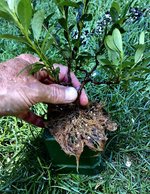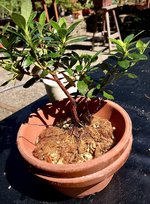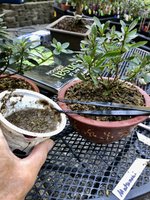Part Two - Potting Waterwashed Azaleas
A great advantage of waterwashing young stock is, properly done, one gets a fantastic start on an awesome nebari. A second is one knows exactly the layout and condition of the roots. Third one knows there is nothing on the roots besides the new media. This gives the hobbyist total control over the process and allows them to narrow down any issues later. Finally, it’s really easy to work the nebari next spring and up pot these to the next size pot.
If I follow this process properly, the only major thing I concern myself about is ensuring proper after care.
I usually use 4.5 - 5” Tokoname training pots for small stock. Once in a while the roots will be small and a 4” pot will be needed. These fit together nicely on a bench, are cheap, relatively sturdy and avoid plastic. I’ve been getting these from NE Bonsai gardens/Bonsai Outlet… yet likely one could get these many other places…like Weigerts etc… and maybe at a better price!
The pot shown below has the screen already installed and the hold down wires placed.
Two things I do perhaps differently then others.
First the wire holes are bored out to 5/16” to give extra drainage. Usually the wire holes are very small, so I submerge the pots in a tray with wood chocks inside and bore these with a diamond bit to enlarge the holes. Bit cost about 18USD.
Second, the tie down wires are twisted and crossed.
At first I didn’t do this, yet on pot after pot I felt the wires slip. Crossing and twisting the wires allow one to have total control of each wire end. Also, on small pots, it doesnt much matter which wire end you use to twist to another… unless one horses the ends to tighten. But gentle Is the key with azalea roots and with Kanuma.
Incidently I’m presently using 90/10 small kamuna/small pumice. I source the Kanuma all over. Pumice comes from General Pumice. Their product comes presorted.

Another thing I do is hold down the roots with a partial basket tiedown. This gives one more control of the roots/trunk.
To make these: take a 3” piece of wire and twist back to form a very small loop on both ends, similar to the butterfly some folks use to install screening. Length varies 3/4 -1” is usual depleting on trunk/root mass. Position these butterfly opposite to one another across the pot, each with the loops threaded through two wire ends on that side. Bend the tie down wire back over the rim with the butterfly firmly up to the top of the rim… or on the rim to keep control of the bow tie.

Next media is added about 2/3 of the way. Try to cone up the media in the middle… almost to the top of the rim so it will rise to meet the base of the trunk while the root tips flare down. The dome will compress as the wires are tightened.
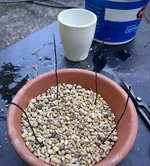
Place the tree into the pot
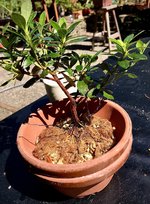
Gently pull one set of two wires across on either side of the trunk, then the other set. Position the butterfly near the trunk… about 3/4” or less away depending on the size and thickness of the roots near the nebari. Big roots, thick nebari hold better so the butterfly can be spaced away a bit more.
The goal is to hold the trunk and roots in position, but not to have to ‘reef’ down a lot when tightening.
btw: If the wires start to displace the roots to one side, when tying off, use a chopstick to tease the roots to each side of the wires to give an equal distribution of the roots around the pot. If all else fails use scissors to snip a little bit to make a clear path for the wire.
Getting ready to tie down.

Initial tiedown.

Once tied down gently, add more media along the sides and
gently chopstick it under the roots as you move around the pot to firm things up. Too much chop sticking will break up the soft Kanuma in the media. This will cause the soil level to sink when watering.
Be careful as this may push the roots out of the media. If this happens, carefully undermine that section, push the roots down and bury them. Leave about 1/4 space of rim left to leave room for moss and ensure proper drainage.
obtw: The time to add solid Biochar, if that’s something you do, is during this step. If ground up, put on top as you are watering in the media the final time.

Now water the surface lightly with a wand. Then submerge the pot in water to just
below the top of the media. (Submerge too deep and the media will float away.) The rationale is this step is done to ensure the media is fully saturated. Drain, repeat until the drain water is clear.
I often leave the tiedown ends sticking out so I can snug down if needed now.
Finally use a wand to water the surface again until the drain water is clear. (You can skip the submerging step if you so desire. I find the media stabilizes better when submerging, but this is up for debate! )


Adding moss. The idea of adding moss is the top portion of the media is very important to the health of the azalea, so I add moss to help stabilize the media and to help protect the roots below.
I use 60/40 Yamagoke/Sphagnum moss shredded, apply it dry, then stabilize the moss by wetting down with a spray bottle. Afterwards mist the entire shooting match.
(Some folks wet the moss for a day in advance, then apply it wet. Sounds like something for me to try out the next time I add moss!)

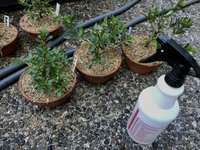

I was just about to post this when I out watering and it struck me there was no mention of timing and care these posts.
Timing
As much as I say Azaleas ain’t Shrinking Violets, if one water washes and then stores an Azalea in the heat or direct sun… the azaleas will resemble Shrinking Violets in short order!
Moderation in temperature is the name of the game. So ideally 50-70F 10-21C would be really nice. Where I live this usually lets me work from about the middle of March to the middle of June.
Could one do this procedure in late September without a special enclosure or greenhouse? I don’t know. Yet I wouldn’t recommend it as I’ve observed my azaleas take 4-6 weeks to recover. Then they push strongly.
How about doing this process at 80F/21C? Might work, haven’t tried yet. Likely with correct aftercare. How about 90F/32C… you’ve got to be kidding!
So waterwashing in late September is cutting it too fine without special protection imho. I do have a couple greenhouses, so I guess later on this year with time, I’ll try it and see how things work out.
Care - Its key to remember is this is major tree surgery! No matter how gentle you were, these roots were damaged and, more importantly perhaps, the rhizosphere has sustained major damage which it will not recover from for at least a couple weeks.
Please do not toss the pot in with the rest of the collection and watch to see what will happen…because you will likely have just added a Shrinking Violet to your collection!
Keep out of sunlight for about 3-4 weeks. Bright shade at max. After that try dappled shade/early morning sun. Ease in to full sun. One will know when the plant has recovered.
Keep out of excess temperatures. Initially roughly over 82F / 28C briefly would be my top limit.
Fertilizer - Wait at least 3-4 weeks or until new growth appears. Start with 1/2 strength liquid fertilizer, wait two weeks… if good then, one can up the amount.
Sound a bit conservative here? Yep! I would rather baby the trees a bit up front for years of enjoyment. It’s a small price to pay.

Cheers
DSD sends
obtw - what if you don’t like this process? Do something else! After all, your trees, your choice!




